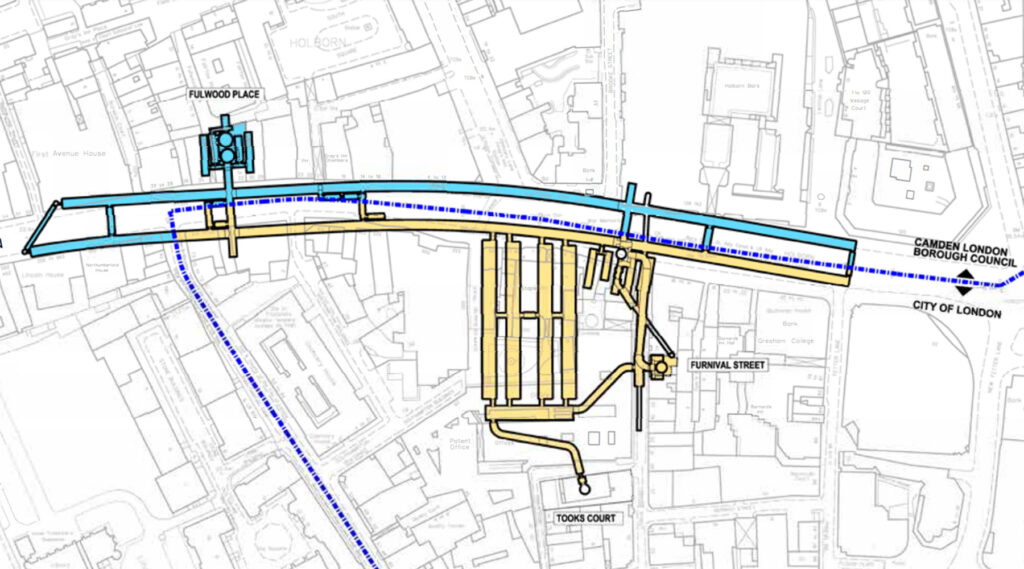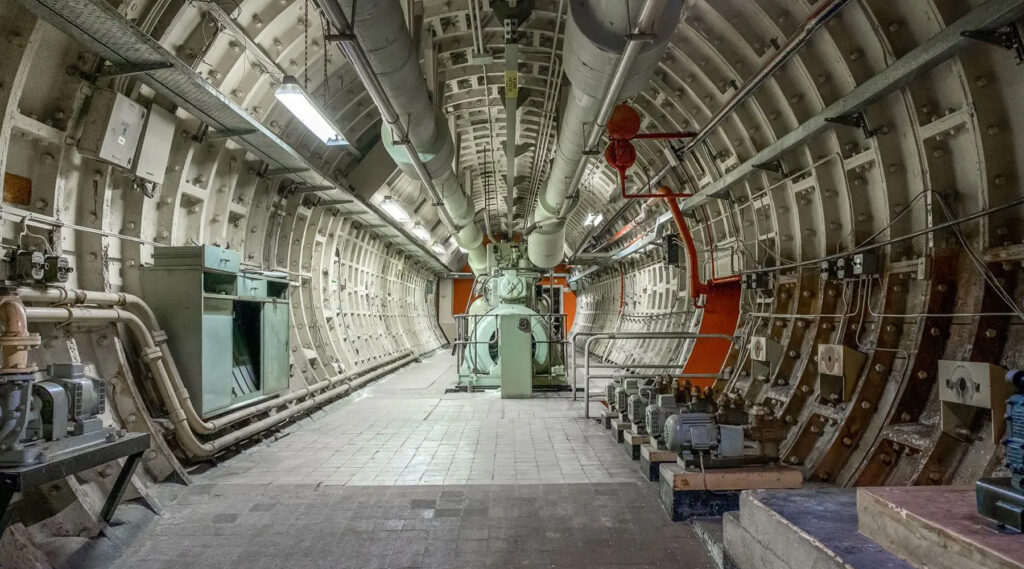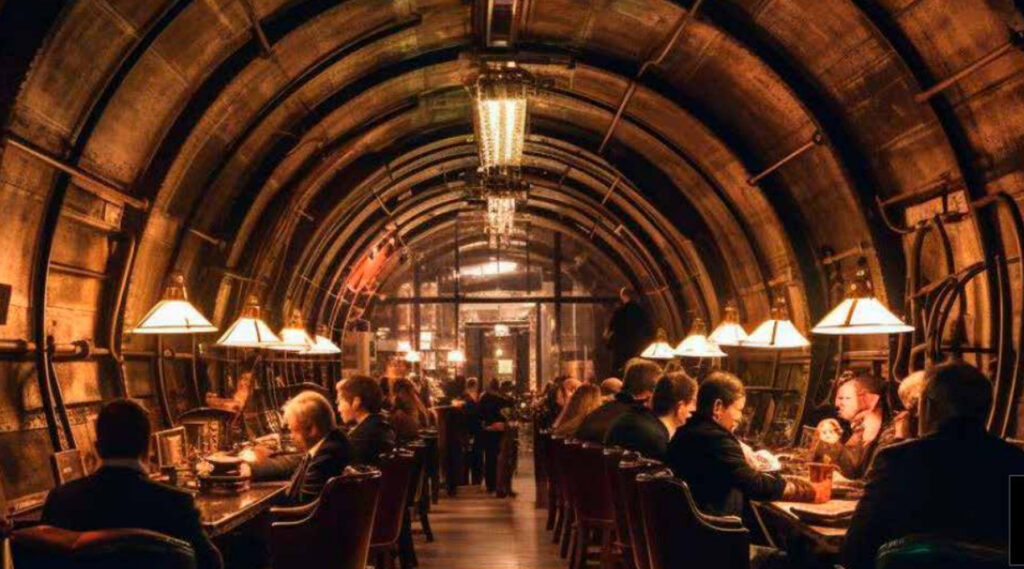Announced a few months ago, more details about the intention to open the secretive Holborn tunnels to the public have emerged.
Built during WWII as shelters from bombs but never used by the public, the tunnels were converted into deep-level telecoms exchange during the Cold War. They became rather legendary in the subterranean world when details about them emerged.
They were put up for sale in 2008, but no serious bidders emerged until recently when fund manager Angus Murray bought the tunnels with the plans to open them to the public.
They are so large that the entrance will be in the City of London, but people will leave within Camden Council territory. The formal planning application has now been filed with the two local councils to decide if the tunnels will open to the public.
The conversion of the tunnels into a visitor attraction will see some of the space used as a permanent heritage display, with some as a temporary exhibition area, which is pretty much how most museum style venues operate.
They expect the venue to attract up to 2 million visitors a year, averaging about 560 per hour, with a peak of 750 visitors and an expected average visit of about an hour. There will also be an underground bar in the tunnels that will operate independently from the main attraction, with a capacity for 160 people.
The main entrance will be on a side street south of High Holborn, in a rebuilt building next to the original entrance shaft. People will leave via another building on High Holborn, where there’s a second access shaft into the tunnels.
A third entrance on Fulwood Place will be for school groups and the bar. Hopefully, they won’t mix the two groups up.
For visitors using the main entrance, the original cast iron rings of the access shaft will be restored. Although to be confirmed, the accompanying drawings suggest that the lifts inside will have glass walls so you can see the lift shaft as you descend to the tunnels. The planning document does say they want the iron rings to be part of the visitor experience.
Down in the tunnels, there are the long WWII tunnels, called the “streets”, hosting the permanent exhibition and branching off them, the much larger Cold War tunnels, called the “avenues”, which will be used for the temporary exhibitions.
The temporary exhibition space will be filled with high-resolution large-scale curved digital screens and projection systems, together with interactive structures, scent-emitting technology, and hundreds of individual acoustic pinpoint speakers.
They describe the avenues as being a “programmable black box – a series of linked spaces that can transform themselves into completely different environments from one presentation to the next”
The intention is that the larger temporary exhibition tunnels can then be used for private and cultural events. People may recall how the South Kensington subway was used for London Fashion Week, and the developer suggests these tunnels could see similar events.
And doubtless hired for corporate launches, dinners and the like.
Away from that, part of the older WWII tunnels turned into “London’s deepest bar”, a space for school groups to use, and obviously, there’s a gift shop on the way out.
There are also a few side tunnels called “alleys”, which will require an article all of their own.
The planning applications are now with Camden and the City of London to decide if they will approve.
The new owner plans to invest an estimated £140 million into restoring, preserving and fitting out the site, with a further £80 million allocated to installing the immersive technology and screens.
Overall, the scheme appears to be well thought through, making the most of the heritage and the obvious constraints of the site while also maximising their appeal and ensuring there’s a sensible long-term financial plan to keep it running as a venue.
If everything goes as planned, The London Tunnels could open to the public in 2027.










Dear Ian – wow! Thanks for telling us about this. I love the Tube and its history and hope this project comes to fruition. Now if I can just hang on till 2027…
I worked for Post OFFICE International Telephones later BTin the 70s and 80s at Faraday International Telephone Exchange.We had unofficial access on night shifts to the extensive cable tunnel network under London.A small group of us on long night shift breaks would cross the Thames under the river to the South Bank and walk westwards to the south bank theatre complex cross back to Holborn and back to zFaraday .One adventurous duo actually got to the base of the Post Office Tower which was an incredible site under ground like a massive buried cathedral tower.We even got to Whitehall but noticed security cameras and turned back.The cable tunnels are extensive and stretch for miles we Faraday Ferrets had many an interesting time exploring them.
A link to the planning application would be good please
https://www.planning2.cityoflondon.gov.uk/online-applications/applicationDetails.do?activeTab=summary&keyVal=S4ZZ5AFHG7200
Great to see them rescued. I haven’t been down there since the 1970s. We called them Faraday Deep Level
Yes but that was then built over by a hotel in Carter lane
In the 1970’s I worked there for BT. Could hear the tube trains above us when in the canteen
Seems very strange to be writing about them since they were not to be discussed openly in the 70’s
That was 50 years ago though – times change.
I visited them about 15 yrs ago on behalf of someone who wanted to buy them to install a data centre. Lots of space for computer servers, great connectivity to the City and very secure. Sadly we couldn’t engineer a way to get the massive amounts of heat it would generate safely to the outside, so that was the end of that plan!
Love your ironic bits, Ian!
Thanks for alerting us. On a pedantic note, a tunnel doesn’t need to be particularly long to have its two ends in different boroughs. Some pedestrian subways under roads probably do that, though for simplicity there may well be an agreement that one borough or the other maintains the whole thing.